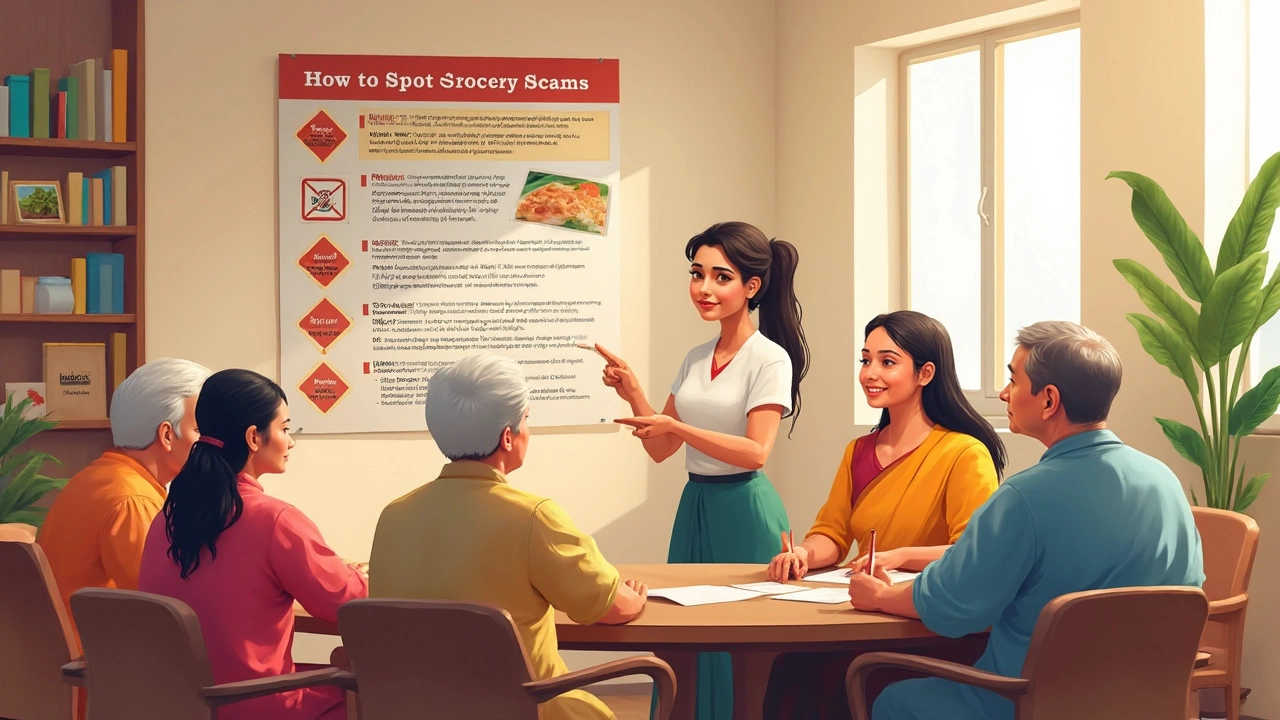Seen those headlines about a $900 grocery stimulus for seniors? You're not the only one. It's all over Facebook, in flashy ads, and even popping up in community forums. But when you try to track down the details or figure out how to apply, the story usually fizzles. So, what's really going on?
So far, there's no official $900 grocery stimulus for seniors sponsored by the federal government. A lot of these claims trace back to viral posts or scammy websites designed to pull people in. They generally want you to enter personal information or sign up for something that never delivers on those big promises. Knowing what's real (and what’s not) is important, especially when you’re counting every dollar at the grocery store.
Still, there are legit programs out there that actually help seniors stretch their food dollars—and you don't have to risk your identity to get them. Think SNAP (what used to be called food stamps), meal delivery programs, or state-specific grocery card programs. If money's tight, knowing where to look and what to avoid can make all the difference.
- Where Did the $900 Grocery Stimulus Story Come From?
- How Grocery Assistance Really Works for Seniors
- Spotting Red Flags: Common Scams and Misinformation
- Real Programs and Practical Ways to Save on Groceries
Where Did the $900 Grocery Stimulus Story Come From?
This whole buzz about a grocery stimulus for seniors started online. If you've seen posts on Facebook or gotten weird emails promising a $900 boost just for groceries, you’re not alone. They usually pop up more when talk of inflation or government relief is in the news.
Most of these stories trace back to viral marketing campaigns, not anything official from the government. Some groups use clickbait headlines to get seniors to click links or give out their personal info. Sometimes the sites are trying to sign people up for mailing lists, but others are a straight-up scam, asking for sensitive details like your Social Security number or bank info. That’s a big red flag.
No trusted news outlets—like CBS, Reuters, or the Associated Press—have ever confirmed the existence of a $900 stimulus just for groceries. The Social Security Administration and USDA have also stepped in to say there's no such thing. Last spring, the Federal Trade Commission put out a warning to watch out for exactly these kinds of scams.
Here’s a quick table showing some real-life differences between legit food help and scams you might see online:
| What You’ll See | Legit Government Program | Fake Stimulus Scam |
|---|---|---|
| Where it appears | Official .gov websites and local agencies | Social media ads, random websites |
| What they ask for | Income verification, proof of residency | Full SSN, bank details, up-front fees |
| How it’s delivered | EBT card, direct deposit, mailed checks | Vague promises, no actual help given |
If you’re ever in doubt, check with a reliable source, like your local Area Agency on Aging, or visit Benefits.gov to see what real food assistance is actually available for seniors. Don’t give away personal info just because a random ad sounds promising.
How Grocery Assistance Really Works for Seniors
There’s a lot of confusion these days about who actually qualifies for grocery help and what’s out there for seniors. Let’s break down the real options—no clickbait, no runaround, just the facts.
The main program most people have heard of is SNAP (Supplemental Nutrition Assistance Program). This is what folks used to call food stamps. Seniors over 60 can apply, and the amount you get each month depends on your income and expenses. Even if you qualify for a small amount, every dollar helps when groceries are expensive.
On top of SNAP, there’s the Senior Farmers' Market Nutrition Program. Not in every state, but lots of places offer summer and fall coupons you can spend on fresh fruits and veggies at farmer’s markets. If you like eating local and fresh, this program is great.
Another option is Meals on Wheels. If cooking is tough, these folks deliver hot meals right to the door—sometimes daily. Many areas have extra help during holidays, bad weather, or emergencies.
Some cities offer local grocery card programs for older adults, usually run by community centers or charities. These cards aren’t huge, but they can cover basics you use every week, like milk, eggs, or bread.
- If you have Medicaid, sometimes there are extra benefits — ask your plan about food allowances or delivery reimbursement.
- Local food banks and food pantries almost always welcome seniors, especially if you’re on a fixed income. Most just ask for your ZIP code and age—no big forms.
- Call 2-1-1 or your local Area Agency on Aging for a quick rundown of options nearby.
Here’s a quick look at what some programs offered in 2024:
| Program | Eligibility | Monthly Benefit |
|---|---|---|
| SNAP | Income & assets | $23 - $291 avg. |
| Meals on Wheels | 60+, limited mobility | Hot meals (daily/weekly) |
| Farmers' Market Coupons | 60+, low-income | $20 - $50 per season |
Every state has different rules, so check with your state’s Department of Human Services or local senior center. The most important thing? None of these real grocery assistance programs require you to pay up front or share anything like your Social Security number online. Stay sharp and stick with the real deals.

Spotting Red Flags: Common Scams and Misinformation
The buzz about a grocery stimulus for seniors has made a perfect playground for scammers. These schemes are sneaky, but once you know what to look for, it gets easier to stay safe. Here’s the gritty truth: the U.S. government isn't handing out $900 worth of free grocery cards to seniors out of the blue. If someone claims otherwise, that’s your first red flag.
Most scams follow a script. They’ll ask for your Social Security number, bank details, or push you to click shady links. Sometimes, they’ll send urgent emails with official-looking logos or promise instant access if you “act fast.” That’s classic bait.
Let’s get practical about spotting trouble. Here are common red flags to watch out for when you see offers about a grocery stimulus or similar government benefits:
- Requests for Personal Info: If you’re being asked for your Social Security number, Medicare number, or banking info to get a benefit, stop right there. Real programs don’t demand this over social media or via email.
- High-Pressure Tactics: Scammers love to rush you. If someone says you’ll lose out unless you act now, that’s a giveaway. Government help doesn’t disappear overnight or require split-second decisions.
- Upfront Fees: You should never have to pay a fee to get a real food assistance program or stimulus. If someone asks for payment, walk away.
- Promised Benefits Sound Too Good: Offers of a flat $900 for anyone, regardless of income or citizenship, just don’t match how the real programs work.
These scam tactics are pretty common. According to a 2023 AARP report, cases of fraud targeting seniors jumped nearly 20% in the past two years, and fake government benefits are one of the top tricks.
| Red Flag | Real Program |
|---|---|
| Requests for SSN by email/social | Apply safely through official websites or local offices only |
| Promises you $900 instantly | Actual benefits depend on income, location, and other factors |
| Asks for money to "unlock" benefits | No real federal program charges entry fees |
If you’re unsure, call your local Area Agency on Aging or visit the official SNAP website. When it comes to elderly care and government benefits, following basic internet safety rules and double-checking sources can save you a bundle—and serious headaches.
Real Programs and Practical Ways to Save on Groceries
If the fancy $900 check isn't coming, let's get into what’s actually out there for seniors needing help with grocery costs. Some programs have been going strong for years, and you might be surprised how much support you can get if you know where to look.
The most well-known is SNAP (Supplemental Nutrition Assistance Program). It's what people used to call food stamps. Rules are different in every state, but if you’re over 60 and living on a fixed income, you might qualify. SNAP gives a monthly amount on an EBT card that works just like a debit card at the grocery store. As of 2025, the average benefit for seniors runs about $120 per month, but some get more depending on their situation.
Besides SNAP, check out these:
- Commodity Supplemental Food Program (CSFP): This gives boxes of staple foods to low-income folks over 60. You’ll get stuff like cereal, canned veggies, milk, and pasta—no cash, just groceries direct to you.
- Meals on Wheels: For people who have trouble getting out or cooking, Meals on Wheels delivers ready-to-eat meals right to your door. It’s more than just food—it’s a safety check, too.
- Senior Farmers’ Market Nutrition Program: This one offers coupons to spend at local farmers’ markets. Fresh fruits and veggies, sometimes honey or herbs too. Not every state runs this, but it’s worth asking your local agency about it.
Here’s a quick rundown for what’s typical across some programs:
| Program | Type of Help | Monthly Value |
|---|---|---|
| SNAP | EBT Card / Grocery Credit | $120 (avg, can be higher) |
| CSFP | Monthly Food Box | Varies (Box value: ~$40) |
| Meals on Wheels | Meal Delivery | Usually free or donation-based |
| Senior Farmers’ Market Program | Coupons for Produce | $20-$50 per season |
To get into these programs, usually you need to fill out an application. Sometimes, there's a phone number for the state office, or a quick visit to your local senior center can get things rolling. The Elderly Care Services department in your city or county also knows what’s available.
And, don’t forget everyday tricks to cut the bill:
- Buy store brands—same food, lower price.
- Check for senior discount days at your local supermarket. A lot of places offer 5-10% off once a week.
- Plan meals before shopping and stick to a list—those impulse buys add up.
- Use loyalty cards and digital coupons. Sometimes you can save $10 just by punching in your phone number at checkout.
"SNAP benefits mean more than just food—they give seniors a little breathing room each month to afford what they truly need," says Lisa Marsh Ryerson, president of AARP Foundation.
So, while there’s no easy payday, these food assistance and savings programs for seniors do add up and can make grocery bills way less scary.
